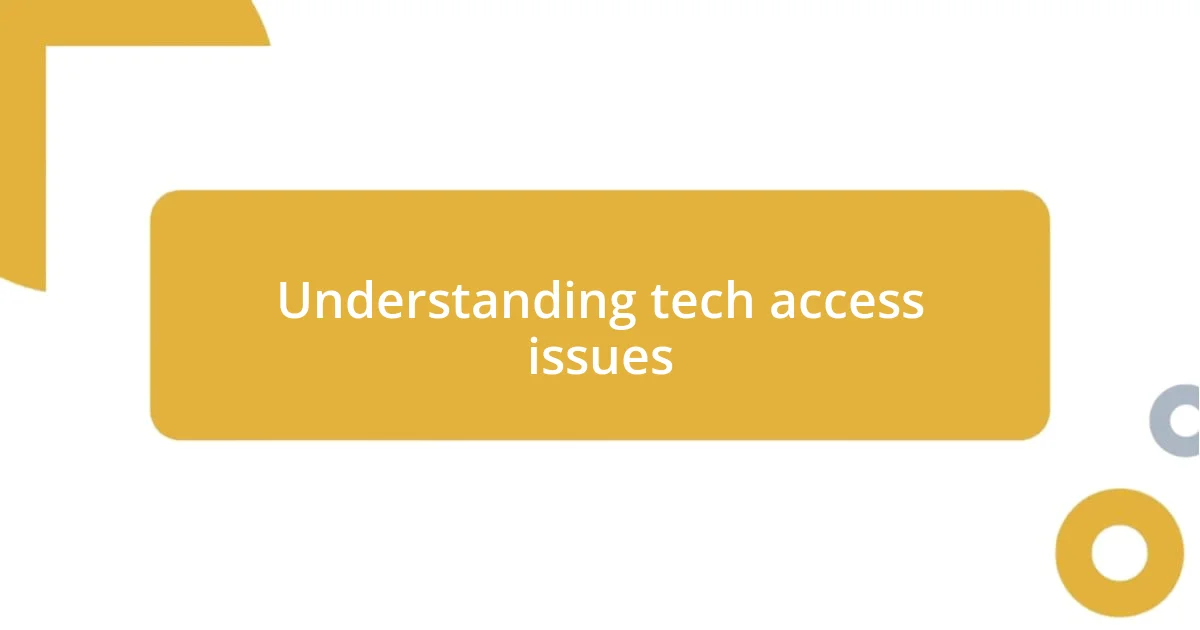Key takeaways:
- Access to technology is crucial for educational advancement, economic opportunities, social connectivity, and improved quality of life, particularly for underserved communities.
- Effective advocacy strategies include community engagement through hands-on training, partnerships with local organizations for resource distribution, and policy advocacy for improved tech infrastructure.
- Measuring the impact of advocacy efforts is vital, with methods such as collecting participant feedback, tracking engagement metrics, and sharing success stories to illustrate the positive effects of increased tech access.

Understanding tech access issues
Access to technology can often feel elusive, especially for those in underserved communities. I remember attending a community meeting where a mother shared her struggle to help her children with online homework due to a lack of reliable internet. Listening to her, I couldn’t help but wonder how many others faced similar challenges, feeling left behind as the world becomes more digital.
When discussing tech access issues, I often think about the barriers many individuals encounter—financial constraints, lack of training, or simply living in remote areas. I once spoke with a senior citizen who wanted to learn how to use a smartphone but felt overwhelmed by the fastest technological advancements. It struck me how daunting it can be for some to even take the first step into a tech-driven world that others navigate with ease.
Furthermore, the digital divide extends beyond just having the latest gadget; it’s about the knowledge and skills required to leverage technology effectively. I’ve witnessed firsthand the frustration of a small business owner who, despite having a computer, struggled with basic software. This experience made me realize that access isn’t just a matter of hardware but also about fostering confidence and competence in using that technology. What are we doing, then, to empower individuals in this digital age? It’s a question we must all ponder.

Benefits of increased tech access
Increased access to technology can be a game-changer for individuals and communities alike. I vividly remember a local nonprofit organization that provided laptops to students, transforming their educational experiences. With these tools, students were not just able to keep up with their peers; they started to excel, gaining confidence and opening doors to future opportunities. It’s remarkable how technology can bridge gaps and create pathways for success.
Here’s a brief overview of the benefits of increased tech access:
- Educational Advancement: Students gain access to a wealth of information and resources, enhancing their learning experience.
- Economic Opportunities: Individuals can pursue new job prospects, oftentimes in tech-driven industries, leading to higher income potential.
- Social Connectivity: People stay connected with family and friends, reducing feelings of isolation, especially for those in remote areas.
- Empowerment: Access to technology fosters confidence as people acquire new skills, allowing them to navigate the digital world with ease.
- Improved Quality of Life: Tech enables better access to essential services, such as telehealth and online banking, making life more convenient.
Reflecting on these benefits, I’ve seen how a single tablet in the hands of an underprivileged child can ignite dreams and aspirations. This kind of access fuels ambition, showing that when technology reaches everyone, the possibilities become limitless.

Strategies for advocating tech access
Advocating for tech access requires a multifaceted approach. I often find that community engagement is crucial; hosting workshops where individuals can hands-on explore and learn about technology has proven incredibly effective. For example, I facilitated a weekend event where local residents learned basic computing skills. The joy on their faces when they sent their first email or created a document was heartening—it reinforced my belief that hands-on learning can break down barriers.
Partnerships can also play an essential role in expanding tech access. By collaborating with local businesses, nonprofits, and schools, I once helped organize a tech drive that collected refurbished laptops for families in need. The impact was profound; not only did families receive the necessary devices, but they also joined a community of learners, sharing knowledge and resources. This experience showed me the power of collective efforts in making technology accessible.
Another strategy that resonates with me is advocating for policy changes that support tech access. I remember advocating for funding to improve broadband infrastructure in my area. It was a long process filled with challenges, but seeing the community come together and voice their needs made it worthwhile. Listening to families express how improved internet connectivity transformed their daily lives reminded me that effective advocacy goes beyond just talking; it’s about creating real change through persistent action.
| Strategy | Description |
|---|---|
| Community Engagement | Hosting events to provide hands-on tech training and support. |
| Partnerships | Collaborating with local organizations to distribute devices and resources. |
| Policy Advocacy | Working with government to improve tech infrastructure and funding. |

Leveraging community resources for advocacy
Community resources are often the backbone of effective advocacy for tech access. I remember volunteering at a local library that organized tech training sessions; it was amazing to see how familiar faces transformed as they navigated new devices. One woman, in particular, had always felt intimidated by technology. Watching her gradually build confidence as she learned to use her smartphone was a powerful reminder of the impact of community support. How many untold stories are waiting to be unfolded if we could only foster such environments everywhere?
I also found that connecting with grassroots organizations can amplify our advocacy efforts significantly. During a recent collaboration with a neighborhood group, we created a shared online platform that allowed individuals to exchange tech skills and resources. This community-driven approach not only built a stronger network but also made tech learning feel less like a chore and more like a vibrant conversation. It struck me how empowering it can be when people help each other; doesn’t that sense of belonging and shared growth resonate with us all?
Additionally, I’ve seen firsthand how local sponsorships can provide critical resources. I once reached out to a small tech company in our area, and they generously donated tablets for a project aimed at seniors. When I witnessed seniors using these tablets to connect with family members who lived far away, it truly touched my heart. Their laughter over video calls was infectious, proving that access to technology goes beyond mere gadgets—it fosters connection and joy in our lives. In what other ways might our communities rally together to enhance tech access and create similar uplifting experiences?

Building partnerships for tech accessibility
Building partnerships for tech accessibility is an endeavor that often sparks unexpected joy. I remember partnering with a local high school’s technology club, where students eagerly volunteered to teach basic coding to younger kids. Seeing those older students enthusiastically share their skills while the younger ones absorbed the knowledge was a proud moment for me. It made me realize how bridges can be built through shared experiences; isn’t it inspiring to witness the power of mentorship and collaboration in action?
I’ve also had extraordinary experiences partnering with local nonprofits focused on serving immigrants. One such project involved providing digital literacy workshops in multiple languages. Those sessions became spaces of encouragement, where many participants who initially felt lost learned not just to navigate technology, but also to share their stories. Their shared struggles and triumphs fostered a deep sense of community. How often do we overlook the richness that diverse backgrounds bring to tech discussions?
Another time, I collaborated with a small business to create a scholarship for underprivileged teens to attend tech camps. Watching the recipients blossom as they developed skills and formed friendships was one of the most fulfilling moments of my advocacy journey. Their enthusiasm for technology mirrored my own as a kid, reminding me of how essential it is to cultivate opportunities. Doesn’t it fill you with hope when we can actively shape pathways for the next generation?

Measuring impact of advocacy efforts
Measuring the impact of advocacy efforts is essential to understanding our effectiveness. In my experience, collecting feedback from participants can provide invaluable insights. During a tech workshop I organized, I handed out surveys at the end, and the heartfelt responses were enlightening. One participant mentioned she had finally secured a job because of the skills she learned, a testament to the profound difference we can make.
I’ve also found that tracking engagement metrics is crucial. For instance, when I launched an online resource hub for tech training, monitoring visitor stats and how many individuals signed up for courses helped me refine our approach. The numbers told a story; they reflected not just interest but a growing community of learners eager to embrace technology. Isn’t it fascinating how data can illuminate what resonates with people?
Another practical method I’ve embraced is storytelling, capturing individual successes to highlight broader trends. I recall a poignant moment when a young man shared his journey from being intimidated by computers to pursuing a degree in information technology. That personal narrative not only inspired others but showcased the ripple effect of our advocacy. How can we better harness these personal stories to advocate for tech access and inspire change in our communities?













